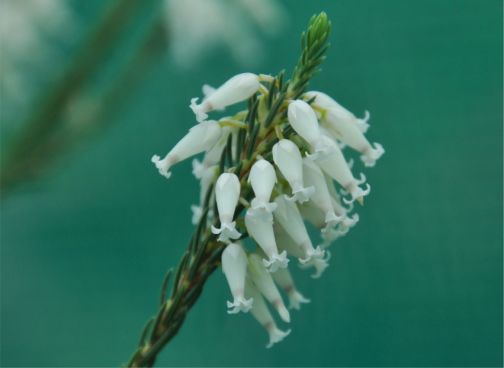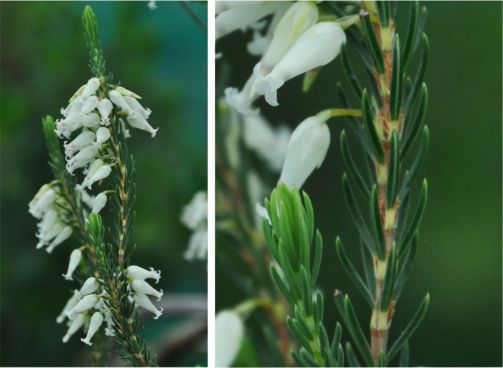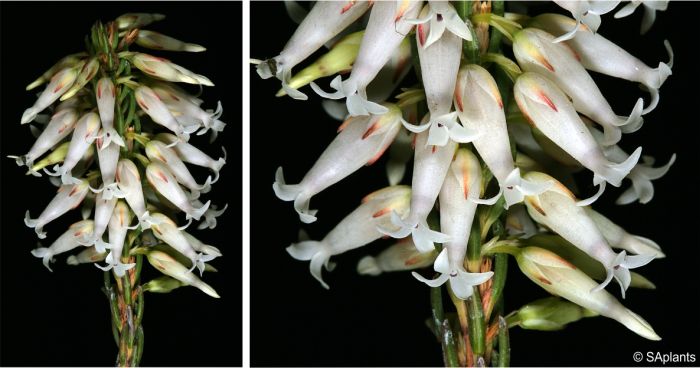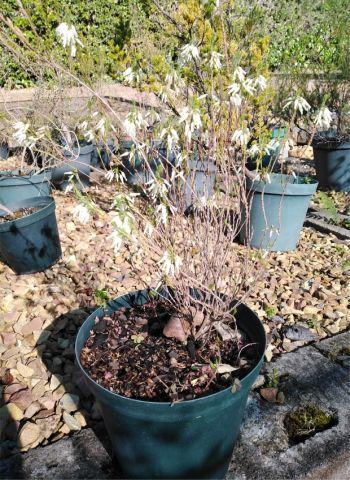Erica heliophila
Erica heliophila Guthrie & Bolus
Family: Ericaceae
Common names: sunlover heath (Eng.); sonliefhebber heide (Afr.)
Introduction
Erica heliophila gives a show of creamy white or pale to deep pink flowers in midsummer (December to February).

Description
Description
Erica heliophila grows up to 600 mm tall and forms an erect or hanging shrub with long slender branches. The leaves are 3-nate, the upper leaves crowded, imbricate (overlapping like roof tiles) and erect, the lower leaves are more distant and sub-spreading. The inflorescence (a flowering structure of more than a single flower ) is axillary (growing out of the axil). The flowers are corolline, meaning that the corolla is the predominant feature, the calyx being small and inconspicuous. The corolla of Erica heliophila is about 6 mm long, urn-shaped with spreading to recurved lobes, white or pale pink to deep pink. The anthers have awns (fine horn-like appendages at or near the base of the anther cell).
Erica heliophila looks similar to Erica tetragona but differs in the following aspects: the flower colour of Erica heliophila is creamy white or ranges from light pink to deep pink and it flowers in midsummer, the hottest time of the year, (from December to February) whereas Erica tetragona flowers are light yellow and are produced from winter to autumn (July to March). The anthers of Erica heliophila have appendages while those of Erica tetragona do not have appendages. Erica heliophila prefers to grow on north or west-facing slopes and can handle more intense summer sun, but likes moist conditions. Erica tetragona also prefers moist conditions but grows on the cooler south-facing slopes of the southern Cape mountains, from around Swellendam to the Uitenhage region.

Conservation Status
Status
Erica heliophila is currently allocated the conservation status of Data Deficient (DDT) and is regarded as Taxonomically Problematic.
Distribution and habitat
Distribution description
This plant prefers damp or marshy conditions and naturally grows on west- or north-facing slopes where it thrives in the full sun for the most part of the day. Erica heliophila is commonly found in the Langeberg range near the towns of Barrydale and Swellendam, growing happily at altitudes of 900 to 1 300m above sea level. The plant is also further distributed in the Robinson Pass, in the Klein Swartberg range and also in the Swartberg south of Prince Albert and as far east as Meiringspoort.

Derivation of name and historical aspects
History
The genus name Erica derives from the Latin word ereiko which means ‘heath’ or ‘broom’. The specific epithet heliophila derives from two Greek words namely helios which means ‘sun’ and philus which means ‘lover’ and probably refers to the plant's flowering time, the hottest and sunniest time of the year, or the fact that the plant likes to grow in a full sun position, the common name of the plant is sunlover heath.
The genus Erica comprises about 800 species, of which approximately 700 species are indigenous to South Africa. Erica heliophila belongs to the Ericaceae family. The genus Erica appears naturally in different parts of the globe which include Europe, the Mediterranean, the islands of the Atlantic and tropical Africa. However southern Africa still remains home to the highest concentration of species, and the Cape Floristic Region is particularly rich in these species, over 600 species can be found in this area alone.

Ecology
Ecology
The small and narrow leaves of the ericas assist the plant in coping with the dry and warm summers by reducing transpiration. Erica flowers come in different shapes and sizes, but in general, the basic flower shapes are the open or closed bell which may be wax-like, smooth or hairy or extremely sticky which may serve as a protection feature for the plant. Erica heliophila was observed being pollinated by insects, the insects visit different flowers foraging for nectar or pollen and contribute in this way to complete the pollination process. Various animals feed off Erica plants.
The seeds of ericas are very fine and often sticky and can lie dormant for long periods in their natural environment, most seeds will germinate when environmental conditions become favourable such as the right soil moisture and the concentration of sunlight.

Uses
Use
Erica heliophila may be grown as a pot plant provided that the potting medium used is in the acidic range usually with a pH of 4 to 5.5 and drains well. This plant can be successfully grown as a companion plant alongside Restio and other fynbos species.

Growing Erica heliophila
Grow
Ericas can grow in a variety of habitats but always prefer soil with good drainage and a low pH (4 to 5.5). In addition to good drainage, they also require a sunny position in the garden and good air circulation, so enough space needs to be provided between plants when planting. Ericas will not grow well in the soil where manure was added or when the concentration of lime in the soil is high and when exposed to intense heat or poor sunlight. Prune the plant lightly after flowering, this will encourage the development of new shoots. Ericas respond well to an organic liquid fertiliser such as a fish emulsion when planting in pots.
Erica heliophila can be grown by taking ± 40-50 mm cuttings two months after flowering, from semi-hardwood, heel or nodal cuttings. Use a rooting medium of fine-milled bark and perlite balls at a 50:50 ratio to improve the chances of successful rooting. Propagation by cuttings has the advantage that a young plant will develop in a shorter time period than when propagating by seeds. Erica heliophila can be successfully grown in a greenhouse, place the cuttings on a hot bench with a constant bottom heat of 24°C. However, cuttings will also develop successfully in an open-air mist spray unit provided that they do not dry out or overheat, to prevent this they can be lightly shaded during the summer months.
Use small pots, about 9 cm, to transplant the rooted cuttings. Transplant the young plants into half-litre plastic bags as soon as the roots develop further and the plant shows some substantial growth. The growth medium to be used at this stage is 7 parts milled bark and 3 parts sand, the young plants need to be watered well and monitored so that it does not dry out. Feed with an organic liquid fertiliser preferably every 2 weeks and shade lightly for a month. The young plants will be ready for planting after about 3 to 4 months.
In South Africa, Western Cape Province, the erica seeds are best sown in autumn, in the months of April and May. Treatment of the seeds with ‘fynbos smoke’ or smoke extract greatly enhances germination. Use seed trays about 100 mm deep, filled with equal parts of river sand and sifted composted bark and ensure that the trays drain well by placing newspaper or a thin layer of stones in the bottom of the tray. Level the mixture by firming it down, the levelling of the soil in the tray will ensure even germination of the seeds. Water the seed tray well before sowing, and apply the water with a fine rose pipe nozzle.
Use fine river sand to mix with the seeds this will prevent the seeds from being sown too densely and thus reduce the chances of damping off. Broadcast the seeds on top of the levelled mix and cover it lightly with some of the mixed sand. Water the seeds again after sowing, do this carefully so as not to spill the seeds from the tray. Do not place the seed trays in direct sunlight or where they will be exposed to rain, always ensure good air circulation. The germination of seeds varies from one to two months. Transplant seedlings into small pots as soon as they reach 10 mm.
Australian mealybug and scale insects can be controlled by applying an appropriate organic contact or systemic pesticide. Control fungal attacks on young plants in the propagation unit by maintaining good air circulation and not sowing seeds too densely.
References
- Casabio, The home of biodiversity. Erica heliophila Guthrie & Bolus. http://www.casabio.org/taxa/erica-heliophila. Accessed 24/10/2023.
- Bolus, H., Guthrie, F. & Brown, N.E. 1909. Ericaceae. Flora capensis 4(1):2–418.
- Inaturalist. Erica heliophila. https://www.inaturalist.org/taxa/1035341-Erica-heliophila. Accessed 24/10/2023.
- Manning, J. & Goldblatt, P. 2012. Plants of the Greater Cape Floristic Region 1: the Core Cape Flora. Strelitzia 29. South African National Biodiversity Institute, Pretoria.
- Oliver, E.G.H. & Turner, R.C. 2007. Erica heleophila Guthrie & Bolus. National Assessment: Red List of South African Plants version 2020.1. Accessed on 2023/10/24.
- Pienaar, K. & Smith, G.F. 2011. The southern African what flower is that? An essential guide to garden plants. Struik, Cape Town.
- SAplants. 2011. Image of Erica heliophila, Caledon Wild Flower Show. https://commons.wikimedia.org/wiki/File:Erica_heliophila_1DS-II_3-8330.jpg.
- Schumann, D., Kirsten, G. & Oliver, E.G.H. 1992. Ericas of South Africa. Fernwood Press, Vlaeberg.
- The World Flora Online. Erica heliophila Guthrie & Bolus. https://www.worldfloraonline.org/taxon/wfo-0000672224. Accessed 24/10/2023.
- Winter, J.H.S., 1972. Ericas: their propagation and care. Veld & Flora 58(1):61-64. Available at https://journals.co.za/doi/pdf/10.10520/AJA00423203_3996.
Credits
Benjamin Festus
Kirstenbosch National Botanical Garden
November 2023
Plant Attributes:
Plant Type: Shrub
SA Distribution: Western Cape
Soil type: Sandy, Loam
Flowering season: Late Summer
PH: Acid
Flower colour: White, Pink
Aspect: Full Sun
Gardening skill: Average
Special Features:
Horticultural zones








Rate this article
Article well written and informative
Rate this plant
Is this an interesting plant?
Login to add your Comment
Back to topNot registered yet? Click here to register.